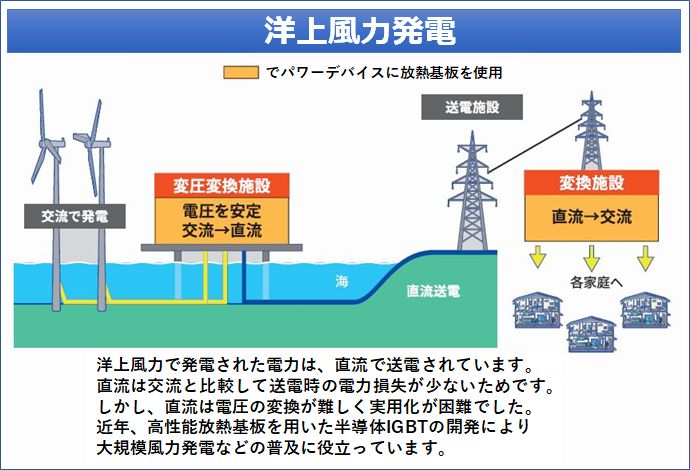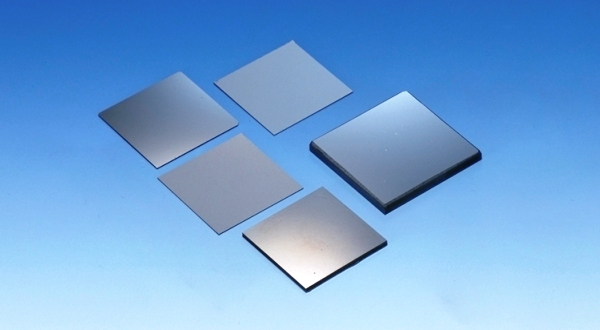Heat spreader (heat dissipation plate) by Applications
Heat spreaders for wireless communications
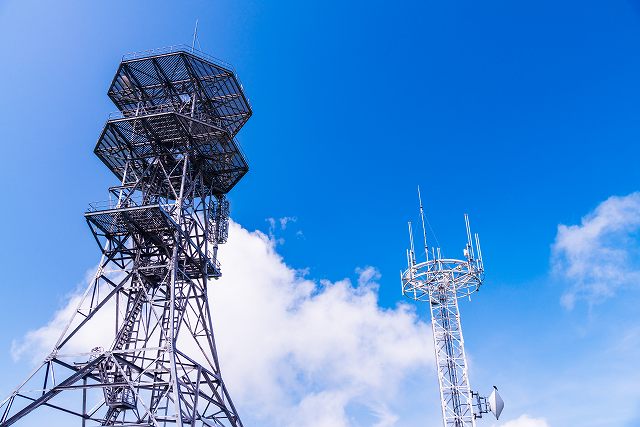
Contributing to High-speed, High-capacity for Mobile Networks
As high-speed, high-capacity communications and device miniaturization become increasingly pervasive, the amount of heat generated by semiconductors for wireless communications is also increasing. 5G base stations (antennas), which are beginning to be widely adopted globally, are equipped with a number of GaN (gallium nitride) chips, a type of compound semiconductor. Although these semiconductors are smaller and higher-performing than convetional silicon (Si) semiconductors, their high heat generation density necessitates efficient cooling methods to ensure the reliability of communication networks. For both Si semiconductors and GaN semiconductors, A.L.M.T. Corp. offers a range of heat spreaders with high thermal conductivity and low thermal expansion. These heat spreaders play a crucial role in the development of next-generation mobile communications networks.
| Applications | Wireless communications, Cell base stations, Aircraft, Ships, Artificial satellites, etc. |
|---|
Cu-W (Copper-Tungsten)
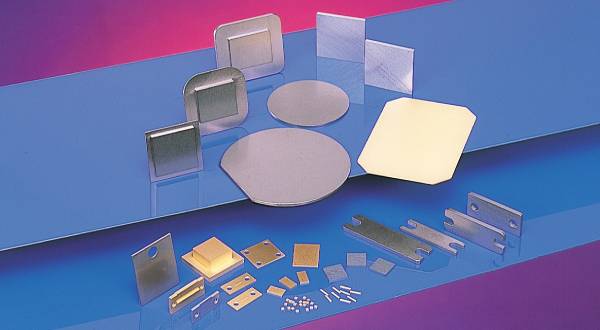
-
This composite material combines the high thermal conductivity of copper (Cu) with the low thermal expansion of tungsten (W), enabling us to adjust its composition to match the thermal expansion coefficient of the surrounding material. With its excellent machinability, it is also widely used in small, complex-shaped parts for wireless communication packages.
Cu-Mo (Copper-Molybdenum)
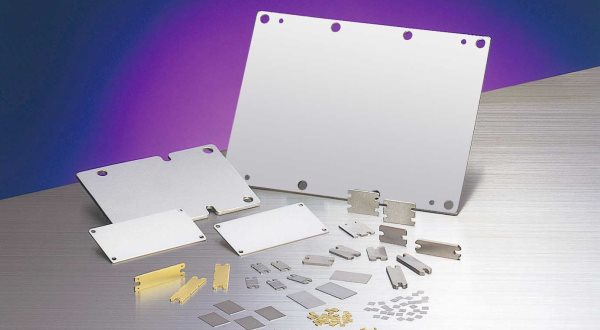
-
This composite material combines copper (Cu), a high thermal conductivity metal, and molybdenum, a low thermal expansion metal. Its composition can be tailored to match the thermal expansion coefficient of the surrounding material. Moreover, as it is suited to mass-production methods such as rolling and stamping, we can provide simple-shaped heat spreaders in large quantities at competitive prices.
Ag-Diamond (Silver-Diamond)
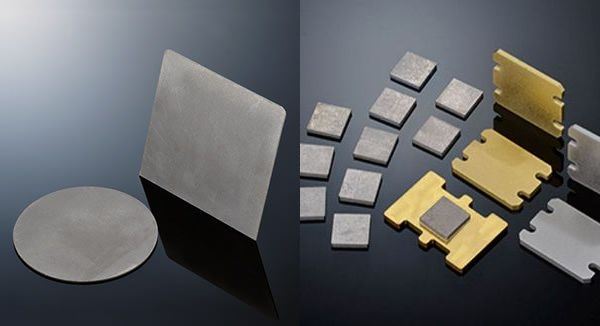
-
Silver has the highest thermal conductivity of metals, while diamond tops the list for natural materials. By combining them using our proprietary technology, we have been able to create heat spreaders with a thermal conductivity of over 600 W/(m・K). Our method allows for the creation of larger components than possible with conventional diamond-based materials, making these heat spreaders an ideal choice for high-output aerospace applications.
CPC™ (Copper, Copper-Molybdenum, Copper)
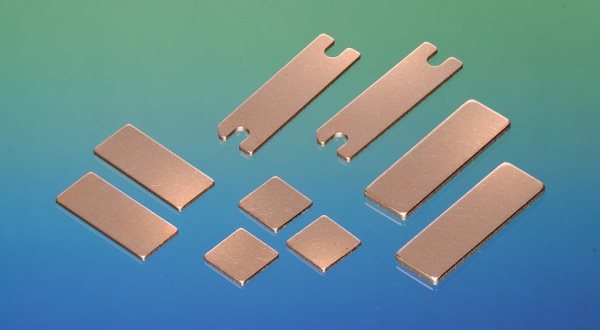
-
This is a three-layered composite with a Cu-Mo core sandwiched between layers of pure copper (Cu). The thermal conductivity and coefficient of thermal expansion can be varied by adjusting the composition of the Cu-Mo core material and the laminate ratio of Cu. Furthermore, due to its Cu surface, the material offers excellent initial heat dissipation. Additionally, it can be mass-produced as efficiently as Cu-Mo materials.
Package Example

Plastic Package
This package is used for compact, low-power devices in base stations. These base stations provide dense coverage for mobile phone networks in urban areas. Cu-Mo (CPC) materials, which have a coefficient of thermal expansion close to that of semiconducting materials, are applicable in this setting.
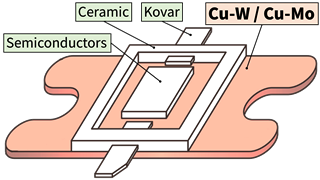
Ceramic Package
This package is used for devices in base stations that have high output and cover a wide range of mobile phone networks. Cu-Mo (CPC) and Cu-W materials, which have a coefficient of thermal expansion similar to that of ceramic housings, are suitable for this package.

Metal Package for Circuit Board
Our heat spreader is used in applications requiring high output and reliability, such as aerospace. In addition to Cu-W and Cu-Mo, which have a coefficient of thermal expansion close to that of metallic housings such as Kovar, Ag-Diamond is utilized in high-end products.
Heat spreaders for optical communications
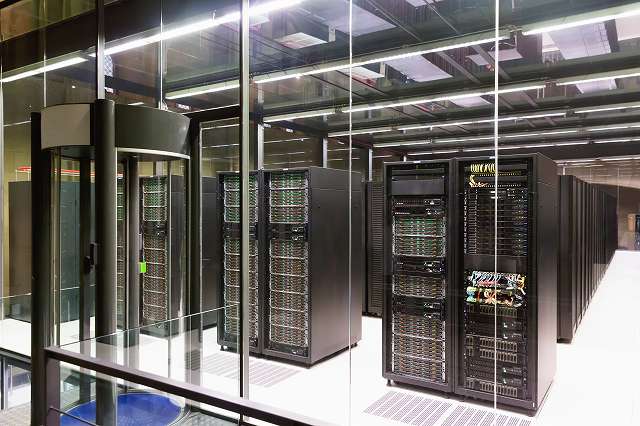
Contributing to High-speed, High-capacity for Optical Communications
Fiber-optic networks, spanning the entire globe from the sea floor to land, support high-speed, high-capacity internet. For newly established data centers in various locations, optical communications remain crucial for connecting high-performance servers. Given that laser diodes, which oscillate optical signals, generate heat, a heat dissipation plate (submount) is mounted directly beneath them. Our heat spreaders can be customized to have various thermal expansion coefficients, and their good machinability makes them suitable for complex and high-precision packaging.
| Applications | Optical communications trunk networks, FTTx systems, Data centers, in-vehicle LAN, etc. |
|---|
Cu-W (Copper-Tungsten)

-
This composite material combines the high thermal conductivity of copper (Cu) with the low thermal expansion of tungsten (W). This allows the composition to be tailored to match the thermal expansion requirements of adjacent materials. It also has excellent machinability and is widely used in components for optical communication packages, which often require small and intricately shaped components.
Cu-Mo (Copper-Molybdenum)

-
This composite combines copper (Cu), a high thermal conductivity metal, and molybdenum, a low thermal expansion metal. Its composition can be adjusted to match the coefficient of thermal expansion for the surrounding material. Its suitability for mass production through rolling and stamping processes allows us to deliver large quantities of simple-shaped heat spreaders at competitive prices.
Cu-Diamond (Copper-Diamond)
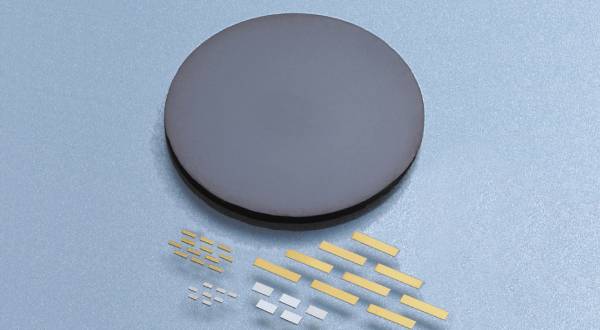
-
This composite material combines copper (Cu), a high thermal conductivity metal, and diamond, which has the highest thermal conductivity of any natural material. Despite its coefficient of thermal expansion being close to compound semiconductors such as GaAs and GaN - the mainstay materials of laser diodes - it boasts a thermal conductivity exceeding 500 W/(m・K), which is higher than that of copper.
AlN (Aluminum Nitride)
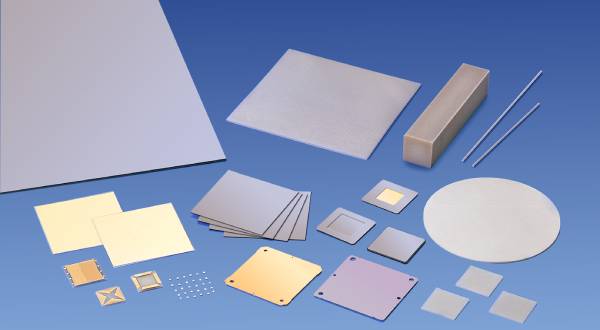
-
This insulating ceramic material boasts excellent thermal conductivity and a coefficient of thermal expansion close to that of Silicon (Si). Ti/Pt/Au metallization can be applied to the surface of the ceramic to provide circuitry, with AuSn partially soldered to facilitate the mounting of laser diodes.
CVD diamond (Chemical Vapor Deposition-Diamond)
Package Example
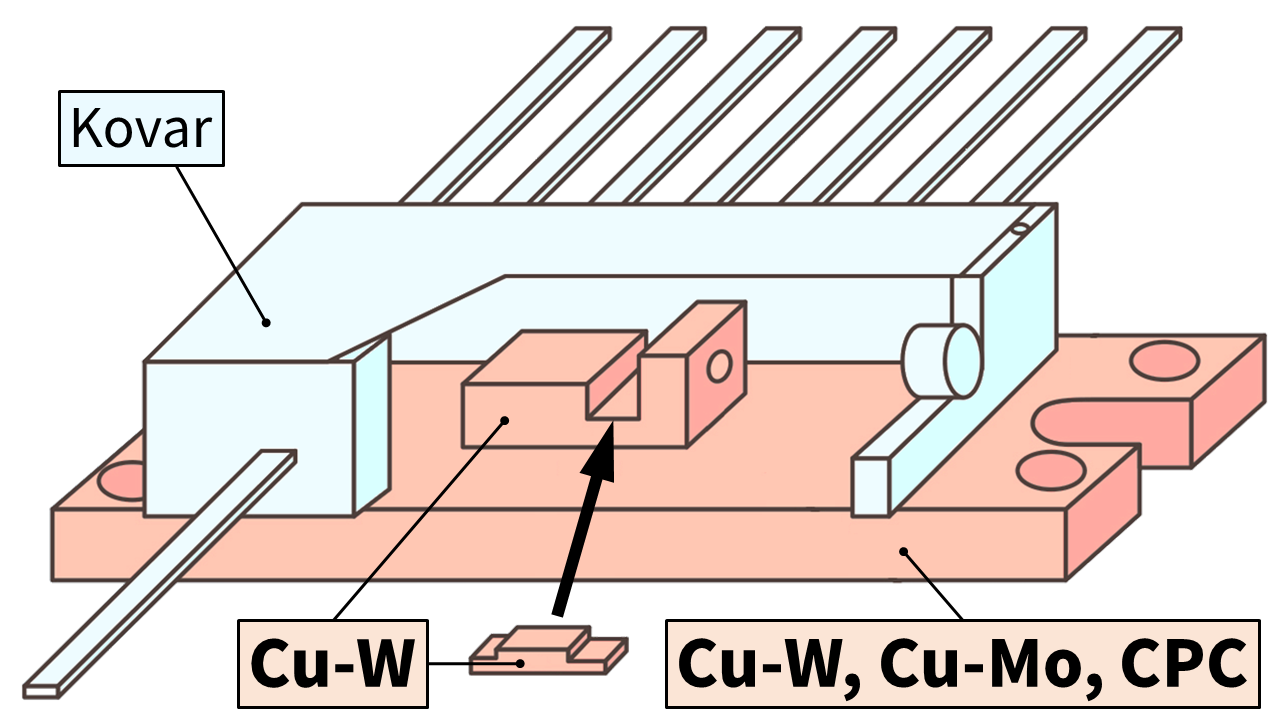
Optical Communication Package
Laser modules, the core components of optical communications, are housed in packages of complex design containing diodes, submounts, and carriers. For the housing materials of these packages, Cu-W, which provides intricate and micro-level machinability, is the applicable heat spreader material.

Chip Carrier and Submount
Submounts are placed just below the laser diode to mitigate differences in the coefficient of thermal expansion between the laser diode and other components below it. In addition to AlN and Cu-W, which both have excellent thermal conductivity, Cu-Diamond is utilized in high-power lasers. Furthermore, micro-machined Cu-W is a suitable material for chip carriers.
Heat spreaders for automotive

Contributing to Safe Driving of Electric and Hybrid Vehicles
With a view to realizing decarbonization, global markets for EVs and HVs (including PHVs and PHEVs) are poised for growth. Power devices, which control power and convert power in electric vehicles equipped with batteries and motors, are indispensable. For powertrain components like inverters and converters that support higher outputs, the use of high-efficiency power semiconductor materials like SiC (silicon carbide) and modules that are cooled from both sides highlight the crucial importance of heat dissipation. Components in HV internal combustion engines, such as fuel injection controllers and radiators, also require heat spreaders. These are crucial for ensuring safe driving. Our heat spreaders, with their high thermal conductivity, thereby contribute to the development of safer, more secure automobiles.
| Applications | PCU(Power control unit) for Hybrid vehicle, Inverter and ECU for Electric vehicle, etc. |
|---|
Cu-Mo (Copper-Molybdenum)

-
This is a composite material made of copper (Cu), a metal with high thermal conductivity, and molybdenum, a metal with low thermal expansion. The composition of this material can be customized for an optimal match with the coefficient of thermal expansion of neighbouring materials. Since it's well-suited to large-scale production through processes such as rolling and stamping, we can provide simple-shaped heat spreaders in large quantities at competitive prices.
CPC™ (Copper, Copper-Molybdenum, Copper)

-
This is a three-layered composite featuring Cu-Mo sandwiched between layers of pure copper (Cu). The thermal conductivity and coefficient of thermal expansion can be adjusted by varying the composition of the Cu-Mo core material and the laminate ratio of Cu. Moreover, its copper surface enhances initial heat dissipation. Additionally, its mass productivity matches that of Cu-Mo materials.
Mo (Molybdenum)
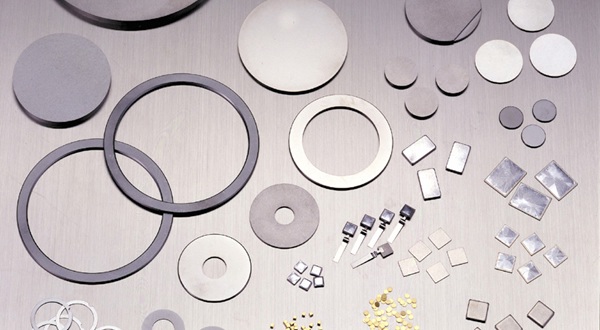
-
Molybdenum (Mo) is a metal with a high melting point close to that of tungsten (W). Its coefficient of thermal expansion is close to that of semiconductor chips (Si, GaN, SiC), making it widely used to reduce thermal stress on such devices. It is easier to machine than other high-melting-point metals and can be processed into complex shapes.
Al-SiC (Sintered Aluminum-Silicon Carbide)
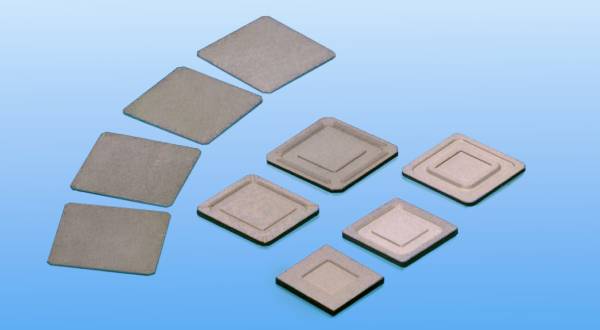
-
This is a lightweight heat dissipation material with a specific gravity that is only one-third that of copper (Cu). The coefficient of thermal expansion can be customized by adjusting the composition ratio. In addition, with Young's modulus only half that of iron, it serves as an effective stress relaxation material for modules. Moreover, the surface of the material exhibits excellent adhesion when bonded.
Package Example

Thermal Buffer Plate
To dissipate heat from IGBT modules that control current for motor drive, one cooling method involves embedding a metallic plate (Cu/Al) or a cooler. Cu-Mo or Mo is placed between the semiconductor chip and the metallic plate, which helps promote heat dissipation and serves as a thermal buffer.
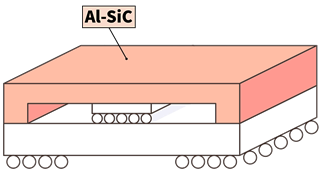
Lid (for ceramics/ organic package)
In the flipchip method, Al-SiC is used as a heat-dissipating plate, acting as a lid to cover the package. In addition to being lightweight, it can be cost-effectively molded into relatively complex shapes, like lids, using dedicated molds.
Heat spreaders for High brightness LED

Contributing to Higher Brightness LED lighting
Compared to conventional light sources, LEDs (Light Emitting Diodes) have a longer lifespan and are more energy-efficient. Previously, their use was limited to household lighting. However, with advancements in high-brightness technology, their application has expanded to include automobile headlights, outdoor lighting, projectors, and more. Looking ahead, by controlling the wavelengths of LEDs, they are also expected to be applied to areas such as the sterilization of drinking water, indoor vegetable cultivation, and medical treatments. On the other hand, LED chips, which are the light-emitting sources, have heat-sensitive characteristics. Therefore, heat dissipation is indispensable for high-brightness LED devices, which tend to generate high temperatures. Our heat dissipation materials have excellent thermal conductivity, and with our proprietary techniques, they can also be processed into complex shapes.
| Applications | Projectors, Headlights, Outdoor lightings, etc. |
|---|
Cu-W (Copper-Tungsten)

-
This composite material, combining the high thermal conductivity traits of copper (Cu) and the low thermal expansion properties of tungsten (W), allows for the adjustment of its composition to fit the thermal expansion coefficient of the surrounding material. It also has excellent machinability, making it widely used in the production of complex-shaped submounts and support wafers.
Cu-Mo (Copper-Molybdenum)

-
This composite material consists of copper (Cu) with high thermal conductivity, and molybdenum with low thermal expansion. Its composition can be customized to better match the coefficient of thermal expansion of the surrounding material. Since it is suitable for mass production with rolling and stamping processes, we can supply large volumes of simply-shaped heat spreaders cost-effectively.
Mo (Molybdenum)

-
Molybdenum is a metal with a high melting point close to that of tungsten (W). The coefficient of thermal expansion is similar to that of semiconductor chips (Si, GaN, SiC), making it widely used to reduce thermal stress on semiconductor devices. It is easier to machine than other high-melting-point metals, and can be processed into complex shapes.
Package Example
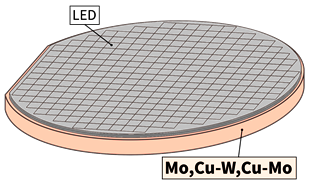
LED Substrate
For higher-performing LEDs which require more efficient heat dissipation, suitable support wafers (Mo/ Cu-W/ Cu-Mo) can be produced as large, thin plates. After forming a light-emitting layer on a sapphire wafer, a heat spreader is joined to peel off the sapphire base material. Once the material is diced, it results in small, thin LED devices.

Submount and carrier
Submounts may be placed directly below the LED chip for heat dissipation and bonding stress relaxation. AlN, Cu-W, and Cu-Diamond are used for the submount, and Cu-W is used for the carriers located underneath.
Heat spreaders for laser
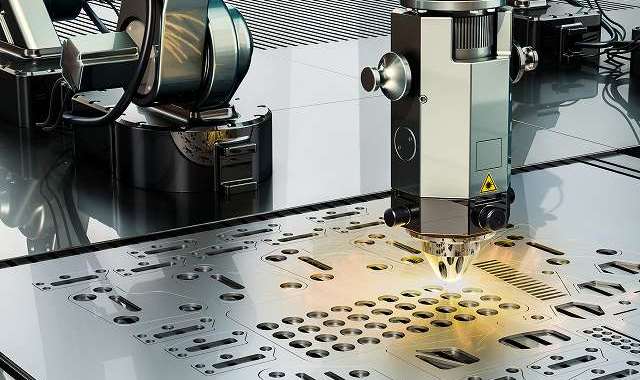
Contributing to Expansion of Applications for Semiconductor Lasers from Metal Processing to Medical Treatment
Laser processing machines are increasingly being used for drilling, cutting, welding, and quenching metals. The use of lasers is also expanding into other fields, including surgical procedures with laser scalpels, cancer treatments, and cosmetic surgery. Semiconductor lasers (laser diodes) employ compound semiconductor materials such as GaAs (gallium arsenide) and GaN (gallium nitride). These semiconductor chips generate heat when oscillating lasers. Therefore, the heat needs to be dissipated by a heat spreader with excellent thermal conductivity. A.L.M.T. Corp. offers a variety of heat spreaders, all with high thermal conductivity and an excellent coefficient of thermal expansion that matches that of semiconductor materials.
| Applications | Welding, Cutting, Beauty care, Medical, Stack (laminated type), etc. |
|---|
Cu-W (Copper-Tungsten)

-
This composite material combines the high thermal conductivity of copper (Cu) with the low thermal expansion of tungsten (W), enabling us to adjust its composition to the applicable thermal expansion coefficient for the specific surrounding material. It is also excellent in machinability and is widely used in the production of complex-shaped submounts and support wafers.
AlN (Aluminum Nitride)

-
This is an insulating ceramic material with excellent thermal conductivity and a coefficient of thermal expansion close to that of Silicon (Si). A Ti/Pt/Au metallization can be applied to its surface to form circuitry. AuSn can be partially soldered onto this to facilitate the mounting of laser diodes.
Cu-Diamond (Copper-Diamond)

-
This is a composite of copper (Cu), a metal known for its high thermal conductivity, and diamond, the natural material with the highest thermal conductivity. Despite having a coefficient of thermal expansion similar to compound semiconductors such as GaAs and GaN, the mainstay materials of laser diodes, this composite material exhibits a thermal conductivity exceeding 500 W/(m・K), which is higher than copper.
CVD diamond (Chemical Vapor Deposition-Diamond)
Package Example

Pumping Bar Type
Heat dissipation is crucial to maintaining high-output performance in bar laser semiconductors that emit laser light. Cu-W and Cu-Diamond are suitable for submounts, placed directly below the exit section, since they have high thermal conductivity and can be processed with sharp edges to avoid obstructing laser emission.

Submount for Single Emitter
The high-power fiber laser machine is embedded with numerous laser diodes of the single-emitter type. AlN and Cu-W are used for submounts located directly below the injection part, which necessitates matching the coefficient of thermal expansion with surrounding materials and having high thermal conductivity.
Heat spreaders for power generation

Contributing to Expansion of Offshore Wind Power Generation
The shift from coal or nuclear power generation to renewable energy is in progress worldwide. Wind power generation, one type of renewable energy, was previously limited to certain areas to secure stable wind flow and prevent noise pollution. As a result, there is growing interest in deploying generators offshore. Since there are no obstructions offshore, a stable supply of wind suitable for power generation can be obtained, and numerous generators can be deployed in close proximity. For long-distance power transmission from offshore to the mainland, direct current (DC), which is less lossy during power transmission, is considered ideal. However, transforming the electrical energy to and from alternating current (AC) inevitably results in substation loss. Hence, due to offshore conditions, power devices need not only high conversion efficiency but also to be compact and maintenance-free. To ensure the stable dissipation of heat generated by the semiconductor chips that support our infrastructure for extended periods, our highly reliable heat-dissipating plate (heat spreader) is applicable.
| Applications | Offshore wind power generation, etc. |
|---|
Cu-Mo (Copper-Molybdenum)

-
This is a composite material of copper (Cu) known for its high thermal conductivity, and molybdenum with low thermal expansion. Its composition can be adjusted to better match the coefficient of thermal expansion of the surrounding material. Since it is suitable for mass production with rolling and stamping processes, we can produce simple-shaped heat spreaders in large quantities at competitive prices.
Mo (Molybdenum)

- This is a metal material with a high melting point, similar to tungsten (W). Its coefficient of thermal expansion is similar to that of semiconductor chips (Si, GaN, SiC), making it widely used to reduce thermal stress on semiconductor devices. It is easier to machine than other high-melting-point metals and can be processed into complex shapes.
Package Example
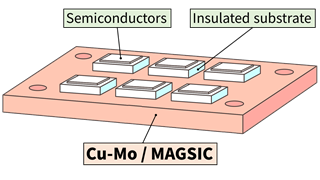
Base plate for power module
For power modules, in order to mitigate the difference in thermal expansion between IGBT chips and packaging materials, it is effective to place Molybdenum (Mo) chip carriers between them as thermal buffer plates. Additionally, these packages can dissipate heat efficiently when Cu-Mo plates are attached.
Heatspraders for electric railways

Contributing to Expansion of High-Speed Railway Network
Japan and Europe have led the world in the field of high-speed railways, including bullet trains. However, in recent years, such networks are also rapidly expanding in China and other Asian countries. The high-speed train converts the high-voltage current collected from its pantograph into a current suitable for motor drive. This conversion is performed by the train's main converter (a converter and inverter). In addition, an IGBT (insulated-gate bipolar transistor) is embedded within the train's control systems. Given the high-speed operation of these trains, associated equipment must be compact and lightweight. The heat generated from power devices is a significant issue. A.L.M.T. Corp. offers molybdenum (Mo)-based heat spreaders that have excellent heat dissipation properties and shape stability, making them suitable for IGBT modules used in electric railways.
| Applications | Inverters, etc. |
|---|
MAGSICTM (Magnesium-Silicon Carbide)
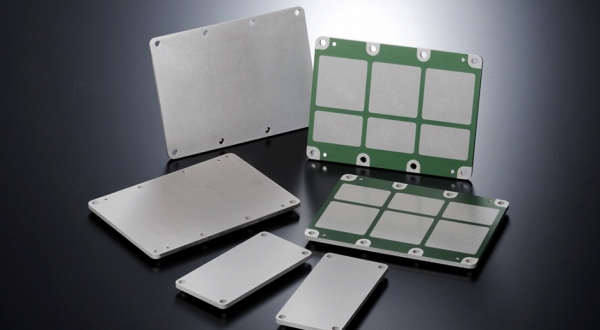
-
This is a lightweight composite material, created using our unique technology to infiltrate Silicon Carbide (SiC) with Magnesium (Mg). It boasts a better coefficient of thermal expansion and thermal conductivity compared to Al-SiC. Also, large-scale mass-production is available. The composition ratio of Mg to SiC can be altered to adjust the coefficient of thermal expansion. Moreover, it provides less variation in warpage.
Package Example

Base plate for power module
Heat dissipation is regarded as crucial for power modules, such as IGBTs, that control motors for high-speed trains due to the increased power density. MAGSIC, compared to the conventional material Al-SiC, has higher thermal conductivity and reduces thermal deformation over extended periods of high-temperature operation.
Heat spreaders for industrial machinery
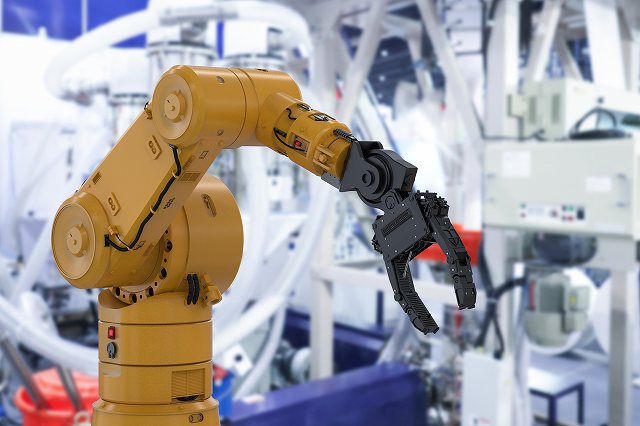
Contributing to the Precise Operation of Robots
High-output motors play a significant role in industrial machines such as robots and elevators, which are widely used in factories, offices, hospitals, and many other locations. These motors, critical to precise control, are equipped with high-performance power semiconductor modules. Efficient heat dissipation is key to their stable operation. A.L.M.T. Corp. offers heat-dissipating plates (heat spreaders) with high thermal conductivity and an adjustable coefficient of thermal expansion tailored to semiconductor chips.
| Applications | Industrial robots, Industrial equipment, etc. |
|---|
Cu-W (Copper-Tungsten)

-
This composite material combines the high thermal conductivity of copper (Cu) with the low thermal expansion of tungsten (W), allowing its composition to be adjusted for a better match with the coefficient of thermal expansion of the surrounding material. This material not only showcases excellent machinability, but is also widely used to create complex-shaped submounts and support wafers.
Cu-Mo (Copper-Molybdenum)

-
This is a composite material of copper (Cu), a high thermal conductivity metal, and molybdenum, a low thermal expansion metal. Its composition can be adjusted to better match the coefficient of thermal expansion of the surrounding material. Since it is suitable for mass production with rolling and stamping processes, we can produce large quantities of simply-shaped heat spreaders at competitive prices.
Ag-Diamond (Silver-Diamond)

-
Silver has the highest thermal conductivity among metals, and diamond has the highest thermal conductivity of all natural materials. By alloying them with our technology, we have produced a heat spreader with high thermal conductivity, exceeding 600 W/(m・K). These heat spreaders can be manufactured in larger sizes than conventional diamond-based materials, and silver brazing is also an option.
Package Example

Thermal Buffer Plate
To dissipate heat from IGBT modules controlling the motor's drive current, a cooling method involving the embedding of a metallic plate (such as Cu/Al) or a cooler can be employed. Cu-Mo and Ag-Diamond are placed between the semiconductor chips and the metal plate. This not only promotes heat dissipation but also functions as a thermal-stress buffering material.
Lineups of Cu-W (Copper-Tungsten) heatspreaders
Scroll to view all
| Material | Trade Name | Composition | Features | Coefficient of Average Linear Thermal Expansion R.T.~800℃ [ppm/K] |
Thermal conductivity R.T.[W/(m・K)] |
|---|---|---|---|---|---|
| Cu-W | W-6 | 94W-6Cu | This Cu-W with a low coefficient of thermal expansion has the close coefficient to GaAs and GaN. And, it prevents mismatches of the thermal expansion. | 6.4 | 141 |
| W-10 | 89W-11Cu | The coefficient of thermal expansion matches alumina. So, it is widely used in ceramic packages using alumina. | 7.9 | 174 | |
| W-15 | 85W-15Cu | The same thermal expansion coefficient as that of beryllia ceramics, widely used for ceramics package using beryllia. It is also widely used for packages using both alumina and kovar because its thermal expansion coefficient is an intermediate value between those of alumina and kovar. | 8.6 | 184 | |
| W-20 | 80W-20Cu | It matches the coefficient of thermal expansion of Kovar and is widely used in metal packages using Kovar. | 9.8 | 200 | |
| W-10N | 89W-11Cu | The coefficient of thermal expansion matches alumina. It is widely used in ceramic packages using alumina.W-10N can provide Cu-W (near-net Cu-W) without periphery process by manufacturing a dedicated mold. | 7.9 | 200 | |
| W-10T | 89W-11Cu | Although it has the same thermal expansion coefficient as that of W - 10, the thermal conductivity is improved by a special manufacturing method; moreover, it is widely used for sub-mount applications for high power lasers because it can keep warp small. | 7.9 | 205 |
Lineups of Cu-Mo (Copper-Molybdenum) heatspreaders
Scroll to view all
| Material | Trade Name | Composition | Features | Coefficient of Average Linear Thermal Expansion R.T.~800℃ [ppm/K] |
Thermal conductivity R.T.[W/(m・K)] |
|---|---|---|---|---|---|
| Cu-Mo | CM-15 | 85Mo-15Cu | This Cu-Mo has a low coefficient of thermal expansion, and has the close coefficient to GaAs and GaN. And, it prevents mismatches in thermal expansion. | 7.6 | 148 |
| PCM30 | 70Mo-30Cu | This material keeps thermal expansion low, and can be manufactured by cost-effective manufacturing processes such as rolling and stamping. | 7.5 | 195 | |
| PCM35 | 65Mo-35Cu | This has the same coefficient of thermal expansion as that of alumina, widely used for ceramic package using alumina. | 7.8 | 210 | |
| PCM40 | 60Mo-40Cu | As its thermal expansion coefficient is intermediate value between the devices (Si, GaAs, GaN, SiC) and copper or aluminum, it is widely used as a stress cushioning material in case devices are mounted on a copper or aluminum plate. | 8.2 | 220 | |
| RCM60 | 40Mo-60Cu | As its thermal expansion coefficient is intermediate value between the devices (Si, GaAs, GaN, SiC) and copper or aluminum, it is widely used as a stress cushioning material when devices are mounted on a copper or aluminum plate. | 10.5 | 275 |
Lineups of Mg-SiC (Magnesium-Silicon Carbide) heatspreaders
Scroll to view all
| Material | Trade Name | Composition | Features | Coefficient of Average Linear Thermal Expansion R.T.~120℃[ppm/K] |
Thermal conductivity R.T.[W/(m・K)] |
|---|---|---|---|---|---|
| Mg-SiC | Mg-SiC | 18Mg-SiC | Since it is lightweighted, it is suitable to be used in larger size; in addition, it has stable warpage, excellent high thermal conductivity and heat dissipation. | 7.0 | 230 |
Lineups of Mo (Molybdenum) heatspreaders
Scroll to view all
| Material | Trade Name | Composition | Features | Coefficient of Average Linear Thermal Expansion R.T.~800℃ [ppm/K] |
Thermal conductivity R.T.[W/(m・K)] |
|---|---|---|---|---|---|
| Mo | Mo | Mo | The thermal expansion is close to semiconductor (Si, GaN, SiC). It is widely used to reduce thermal stress on semiconductors. | 5.7 | 142 |
Lineups of Cu-Diamond (Copper-Diamond) heatspreaders
Scroll to view all
| Material | Trade Name | Features | Coefficient of Average Linear Thermal Expansion R.T.~400℃[ppm/K] |
Thermal conductivity R.T.[W/(m・K)] |
|---|---|---|---|---|
| Cu-Diamond | DC60 | The heatspreader with high thermal conductivity has coefficient of thermal expansion suitable for compound semiconductors (GaAs, GaN). | 6.0 | 550 |
| DC70 | 6.5 | 500 |
Lineups of AlN (Aluminum Nitride) heatspreaders
Scroll to view all
| Material | Trade Name / Composition |
Features | Coefficient of Average Linear Thermal Expansion R.T.~400℃[ppm/K] |
Thermal conductivity R.T.[W/(m・K)] |
|---|---|---|---|---|
| AlN | AlN(200W) | It is useful when insulation and patterns are required. | 4.5 | >200 |
| AlN(170W) | 4.5 | >170 |
Lineups of CPC (Copper, Copper-Molybdenum, Copper) heatspreaders
Scroll to view all
| Material | Trade Name | Composition | Features | Coefficient of Average Linear Thermal Expansion R.T.~800℃[ppm/K] |
Thermal conductivity R.T.[W/(m・K)] |
|---|---|---|---|---|---|
| CPC | CPC141 | Cu/Cu-Mo/Cu | Has the same thermal expansion coefficient as that of alumina ceramic, widely used for ceramic package using alumina. As the surface is copper with high thermal conductivity, it has excellent heat diffusion. | 7.6 | 200 |
| CPC232 | Laminated in "Cu:Cu-Mo:Cu=2:3:2(thickness)" to adjust the coefficient of thermal expansion and thermal conductivity. | 8.4 | 235 | ||
| CPC111 | Laminated in "Cu:Cu-Mo: Cu=1:1:1 (thickness)" to adjust the coefficient of thermal expansion and thermal conductivity. | 9.8 | 260 | ||
| CPC212 | Laminated in "Cu:Cu-Mo: Cu=2:1:2 (thickness)" to improve the thermal conductivity to 300W/ (m・K).It is widely used to realize the performance of high-power devices (GaN, SiC). | 12.1 | 300 | ||
| CPC-300 | It has a very high thermal conductivity, 300W/ (m・K), and is widely used to realize the high performance of high-power devices (GaN, SiC).The thin plates, 0.5mm, are also available. | 12.1 | 300 |
Lineups of CVD diamond (Chemical Vapor Deposition-Diamond) heatspreaders
Scroll to view all
| Material | Features | Coefficient of Average Linear Thermal Expansion R.T.~100℃[ppm/K] |
Thermal conductivity R.T.[W/(m・K)] |
|---|---|---|---|
| CVD-Diamond | This is a diamond heatspreader of 0.1 to 0.4 mm produced by the CVD method (Chemical Vapor Deposition). | 2.3 | >1000 |
Lineups of Al-SiC (Sintered Aluminum-Silicon Carbide) heatspreaders
Scroll to view all
| Material | Trade Name | Composition | Features | Coefficient of Average Linear Thermal Expansion R.T.~120℃ [ppm/K] |
Thermal conductivity R.T.[W/(m・K)] |
|---|---|---|---|---|---|
| Al-SiC | β8 | 70SiC-30Al | By using a special mold, it can be manufactured cost-effectively without processing. The thermal expansion coefficient is variable according to the package type. | 8.0 | 140 |
| β9 | 65SiC-35Al | 9.0 | 130 | ||
| β14 | 45SiC-55Al | 14.0 | 160 |
Lineups of Ag-Diamond (Silver-Diamond) heatspreaders
Scroll to view all
| Material | Trade Name | Features | Coefficient of Average Linear Thermal Expansion R.T.~800℃[ppm/K] |
Thermal conductivity R.T.[W/(m・K)] |
|---|---|---|---|---|
| Ag-Diamond | AD90 | The thermal conductivity is 600W/(m・K) and higher than Cu-Diamond. It is applicable to large size purpose as 50×50m |
10.5 | 600 |
バーレーザ実装イメージ
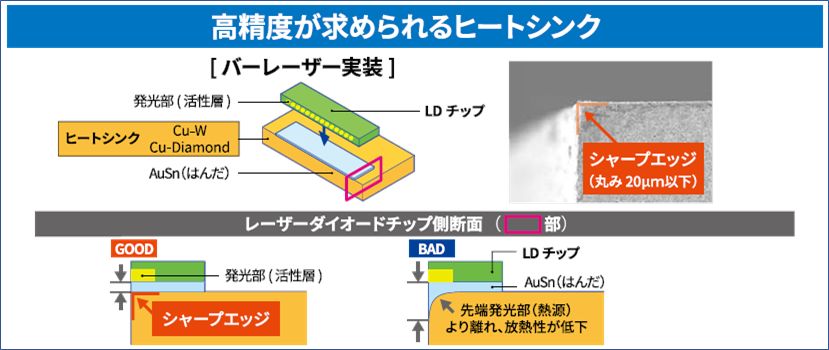
ヒートシンクとなる AIN、Cu-W、Cu-Diamond はシャープエッジ(ピン角)に加工できるため光路を妨げず、エッジ先端部で発光する LD 部の放熱性を高めます。また、はんだ流れを制御する技術により、安定したレーザ性能を実現します。
自動車用パワーモジュール(Cu-Mo)
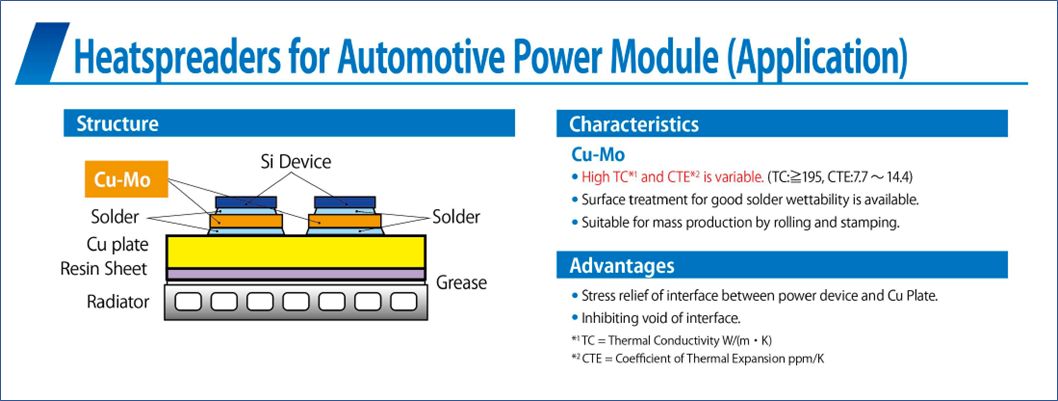
自動車用パワーモジュール(Mo)
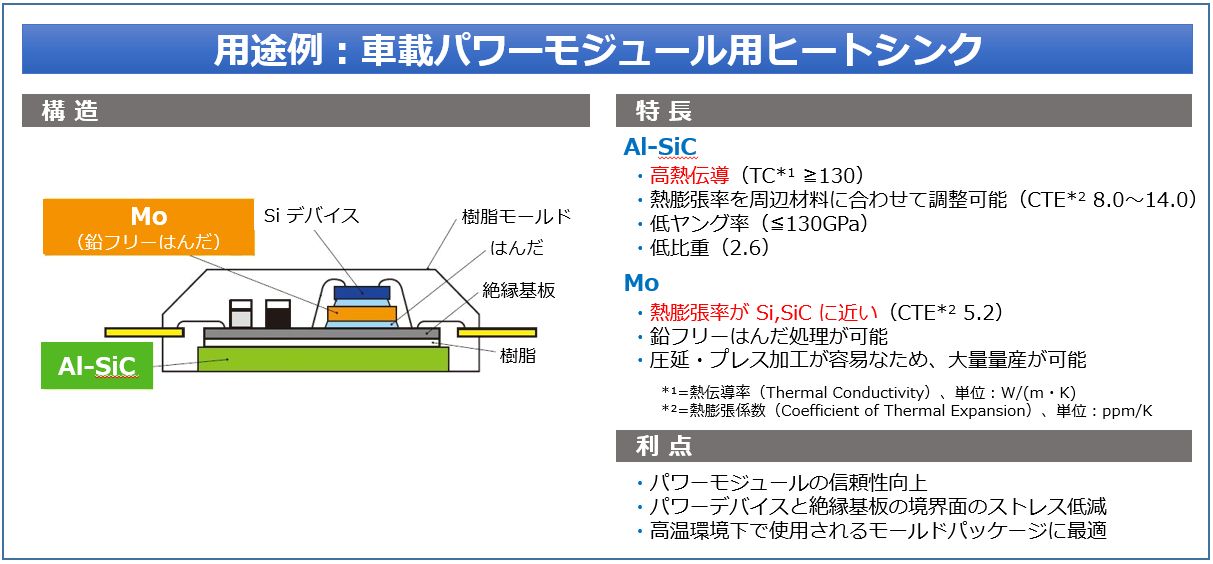
IGBTモジュール
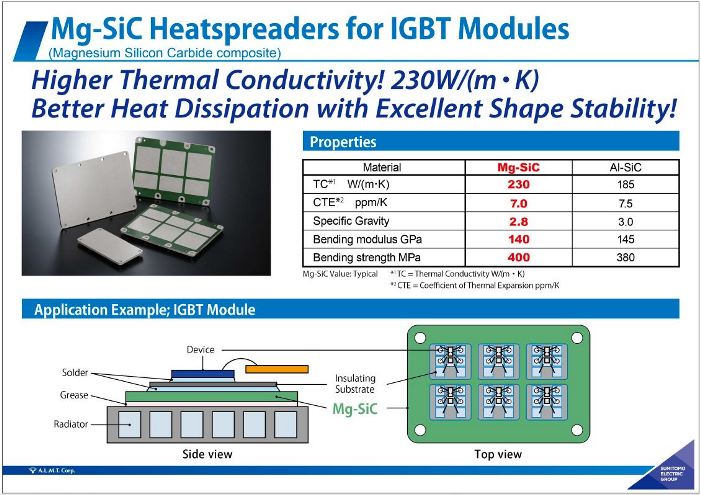
自動車用SiCデバイス
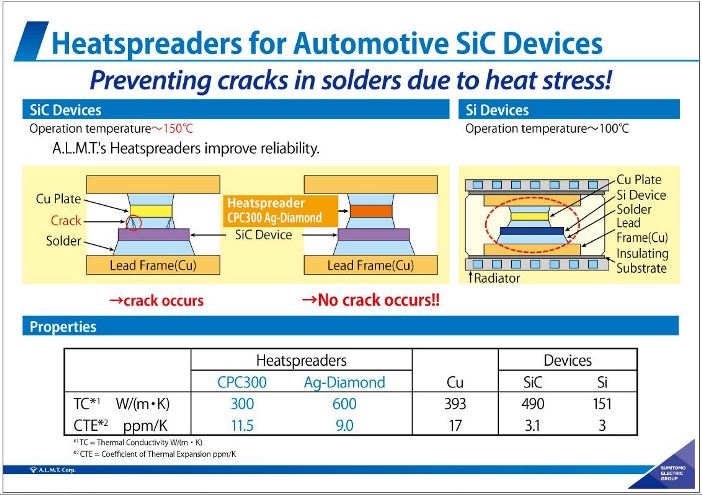
高輝度LEDの作り方
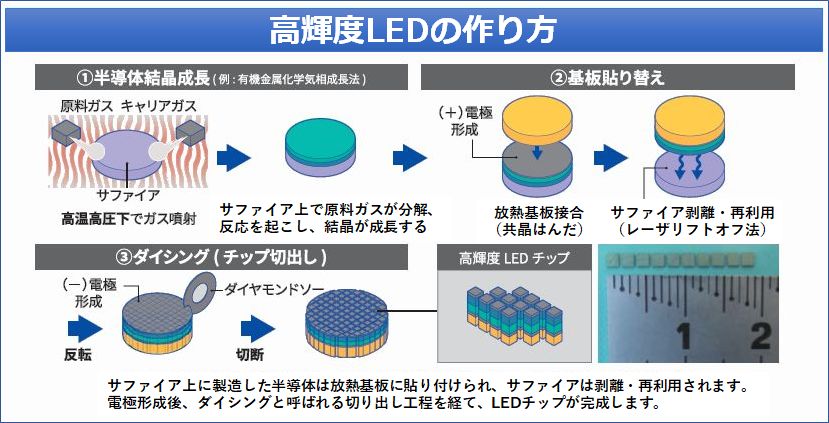
高輝度LEDの構造
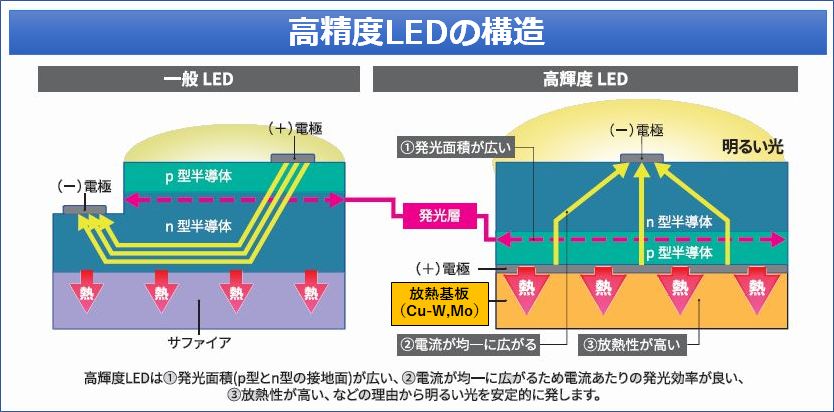
LEDヘッドライト(AIN サブマウント)
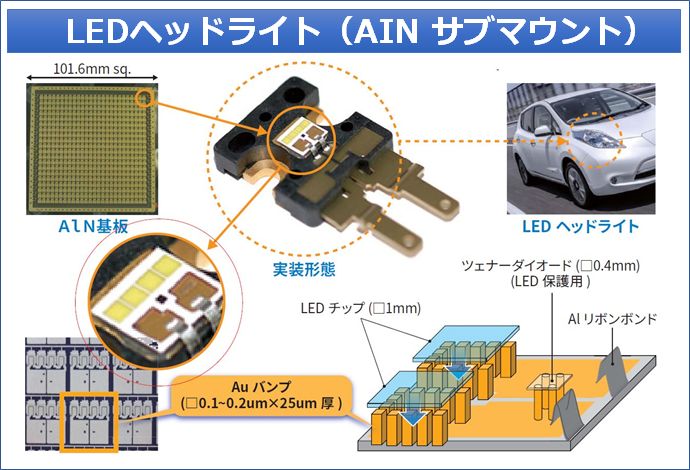
洋上風力発電
